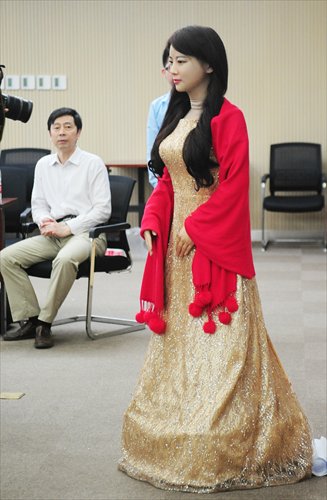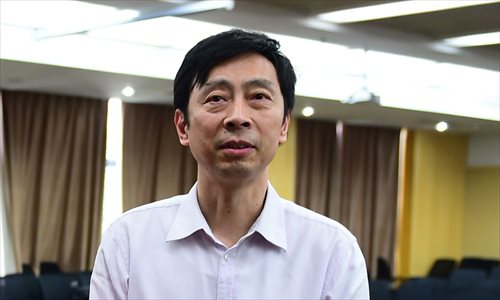Professor instills ‘Chinese virtues’ in service robot

Jiajia looks lifelike wearing a dress and a shawl. Photo: CFP
With her fair skin, rosy cheeks and wide eyes, you can easily mistake Jiajia for a beautiful woman. But once she starts to speak, you'd realize that she's a humanoid robot.
Jiajia, the fembot that was unveiled this month at the University of Science and Technology of China (USTC) in Hefei, Anhui Province, impressed crowds with her human features. Jiajia can speak, move her lips, respond to questions and show a limited number of expressions.
Jiajia is the brainchild of 61-year-old Chen Xiaoping, professor at the university's computer science department, and his colleagues. The Global Times talked to him about his experience in the field of artificial intelligence (AI) and the story behind Jiajia.
Following footsteps
While the field of AI research started in the US in the 1950s, it took off much later in China. Until the early 1990s, it was an idea that was so ahead of time that it was rather neglected. Most Chinese computer scientists focused on either computation theory, a field in which it was easier to make academic achievements, or software coding, which had more practical and commercial value.
Chen had initially focused on computation theory. But he chose to shift to AI.
"I was really interested in it, and I had this belief that it would one day become meaningful," he said.
The Internet was a new thing in the 1990s, and access to new ideas and information was much more limited than today. To follow the latest academic progress on AI, Chen visited Beijing for several months every year, spending most of his time in the then Beijing Library and the library of the Chinese Academy of Sciences, where the latest papers about science and technology could be found. But even these papers were far from up-to-date and many were written one to two years prior.
Just like most Chinese scientists back then, Chen said he initially focused on the specific theoretical problems that Western scientists couldn't work out. This proved fruitful, at least academically. In 1999, during the International Joint Conference on Artificial Intelligence, the main international gathering of AI researchers, Chen's paper "A logic of intention" was the only paper by a Chinese scientist that was presented and published in the proceedings of the conference.
While he started to gain international recognition, Chen felt focusing on these theoretical issues wasn't the path to technological advancements.
"Basically what we did was to read the papers by scientists in developed countries and follow their footsteps. There was very little innovation in our work, and I decided that there had to be a change," he said.

Chen Xiaoping,creator of Jiajia Photo: CFP
Creating his own
He decided to put theory into practice and design real robots. Though he had little experience with machinery, the professor started by working on AIBO, the four-legged robot made by Sony Corporation as the research hardware platform.
In 2000, Chen's team was the first Chinese team to take part in the RoboCup, an annual international robotics competition that promotes robotics and AI research, which had a soccer contest based on AIBOs of different designs. Chen's team moved up in ranking each year, and in 2008, it was runner-up in the Standard Platform League of RoboCup. As a reward, Chen was able to buy four four-legged robots at a relatively low price, which became the basis for his future humanoid robot research.
In 2008, Chen shifted his research focus to humanoid robots and started a project that he called "Kejia." The idea comes from an ancient Chinese fairy tale, in which a fisherman returns home every day finding his home in perfect order, and later finds out that all the housework was done by a fairy who transformed from a conch that he saved one day while fishing at sea. Chen wanted this robot to be able to perform such service for humans one day.
While it is now adorned with long black hair, a golden gown and a red shawl, Jiajia was initially a pile of machines, chips and wires. To design her face, in July 2012, Chen's team put up an ad on USTC's online forum and asked netizens to select five female students to become Jiajia's face. Their faces were then 3D-scanned and made with silicone to be used on the robot.
But Chen's team disagreed about which face to become its standard appearance. "After discussion, we decided that Jiajia's appearance has to be in line with its function. It should reflect three Chinese virtues: kindness, diligence and wisdom," Chen said.
While it now has a beautiful face, its soul - the functions of the robot - is still being improved. So far, Jiajia is being taught deep learning abilities.
"For example, if you give her instructions to a microwave oven, she will be able to operate it," Chen said.
Since Chen believes that robots should be better than cold machines in their relationship with humans, he also equipped Jiajia with the ability to identify the expression of her user and respond to it.
So far, Kejia and the third generation model Jiajia have already made a number of accomplishments in practice. Jiajia hosted this February first Chinese Robot Spring Festival Gala, a show in which all the performers who danced, drummed and played Tai Chi to music are robots. In March, it co-hosted a Go contest on television. It will also meet the public at this week's Shanghai International Technology Fair.
These accomplishments bring Professor Chen one step closer to his goal - to introduce a service robot to the market.
"It's still too early to predict when the robots can enter everyone's homes, but it won't be something very far away," he said.
Newspaper headline: Fembot father